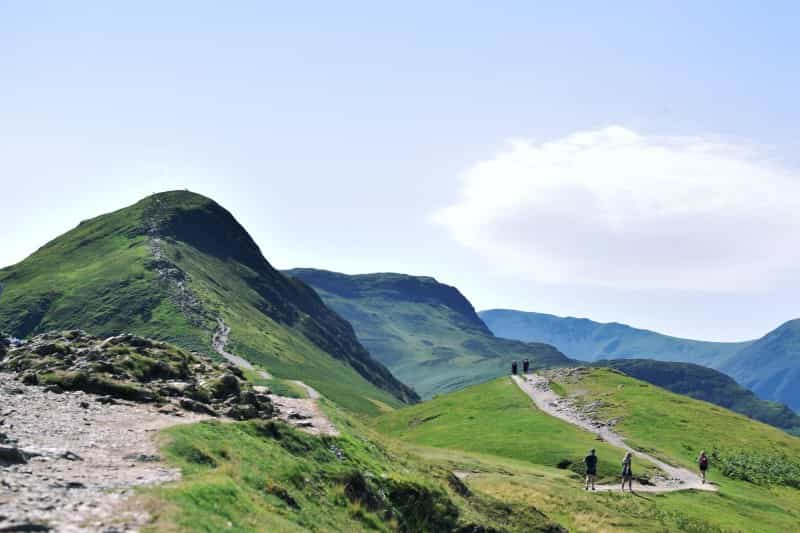8 Scenic Cumbria Walks To Try On Your Next Visit
There’s an abundance of scenic walks in Cumbria – a characterful county in the North West of England that’s bordered by Northumberland, County Durham, North Yorkshire and Lancashire.
It’s the third largest county in England and home to the tallest mountains, the deepest lakes and, of course, the Lake District National Park. There’s an impressive 214 peaks in total here, so there’s plenty of land to explore on foot and lots of fine walking routes and scenic trails to choose from.
From hardcore hikes up Scafell Pike and High Stile to slow strolls through pretty villages like Brougham and St Bees, this region has an excellent selection of walks to suit every level and ability. As soon as you approach the region, have your camera at the ready – the local landscape is simply spectacular.
The county is a truly special place with so much beauty and nature to appreciate, so consider staying at a recommended campsite in Cumbria for a few nights to make the most of it all. It’s also worth taking a look at our Ultimate North West Region Camping Guide before visiting, especially if you’re looking to visit neighbouring counties during the same visit.
Here’s our guide to the top 8 scenic walks in Cumbria, so tie those laces, stretch those legs and get ready to plan your next trip…

Explore the North Pennines
With its wild woodlands, dramatic waterfalls and traditional dry stone walls, you’d be hard-pushed to find a better place to hike than the North Pennines. It’s the UK’s second largest Area of Outstanding Natural Beauty (AONB), and whether you’re roaming around the open moorland landscape of the fells or exploring the more intimate atmosphere of the dales, it’ll be an unforgettable walking experience that you’ll wish you’d experienced sooner.
Start off by spending a while on the Derwent Gorge North Pennine Birdwalk – the trail is only 1.3 miles long, but it’s a brilliant way of getting a feel for the rugged landscape. Next, the oak forest at Derwent Gorge, a National Nature Reserve that’s rich in unusual species of rare plants as well as chatter from birds such as yellowhammers, linnets and skylarks.
There’s also the Blanchard Geotrail, a 3.5-mile circular walk around one of the prettiest villages in the North Pennines – glaciers, tropical seas and miners have all played their part in shaping this landscape over the last 300 million years. The route will introduce you to some special features in the local buildings, moors and fields so you can begin to ‘read’ the ground beneath your feet and uncover the region’s fascinating geology.
Escape to Eden Valley
Eden Valley is a paradise for walkers. This popular wildlife haven is located between the North Pennines and the Lake District, so as you can imagine the scenery is pretty special.
The Brougham and Eamont Bridge Trail here is just under four miles long and will take you past a couple of rivers, a castle, a Roman fort and a fortified manor house. You’ll get a good dose of history in a short amount of time, as well as pleasant views over the lush slopes of Beacon Hill above Penrith.
To the south of the valley are a group of small hills known as the Howgill Fells – a favourite of Alfred Wainwright, the British fellwalker and guidebook author. These fells are well worth a visit for some uninterrupted hiking and undisturbed views.
There are some lovely waterside walks to be had alongside the river Eden – which, interestingly enough, is one of the only large rivers in England that flows northwards.
Browse campsites in Penrith to use as a base for exploring the Eden Valley.

Scafell Pike walk, Lake District National Park
This eight-mile walk is not for the faint-hearted – at 978 metres above sea level,Scafell Pike is the tallest and most prominent mountain in England. It’s part of the Lake District National Park and was gifted to the National Trust after World War I, so it’s also Britain’s most dramatic war memorial.
There’s a couple of routes to choose from, but whichever you decide to take it’ll be a tough climb that involves a bit of scrambling at various points. The easiest and most popular way of getting to the mountain is via Brown Tongue, starting and finishing in Wasdale Head Green.
If you’re up for a longer walk, then cross the western flank from Sty Head and along a narrow path known as the ‘Corridor Route’, just below the summit at Lingmell Col. The climb is worth the effort – when you finally get to the top of Scafell Pike, the views are outstanding.
To the adventurers who are up for the challenge: give yourself six hours to complete the walk and don’t underestimate the difficulty of the terrain. Remember to check the mountain forecast in advance and come prepared with a map and compass.
Don’t fancy climbing a mountain? That’s okay, you can always try the Allerdale Ramble instead. It’s a long-distance path that starts in the Lake District National Park and continues towards the Solway Firth coast. You can make your own walk out of it and go at whatever pace suits you best.
Sleep under canvas at one of our campsites in the Lake District.

Climb Cat Bells
Cat Bells is a popular and distinctive landmark that’s 451 metres high and just three miles from the bustling market town of Keswick. It’s a brilliant location for those who are new to fell walking as it’s not too challenging or too far distance-wise.
There’s a selection of routes to choose from depending on how you’re feeling and what the weather is like. For a short, circular walk that takes around an hour and a half to complete, start at the Skelgill Bank car park and head straight up. It’s moderate in terms of difficulty, as there’s a couple of short and sharp climbs as you approach the summit.
Alternatively, try the longer, more varied walk along Derwent Water’s edge and return via the Cumbrian Way. It’ll take closer to three hours in total but means you’ll get to see the woodland of Manesty Park, which is well worth the extra steps.
If you’ve got the time and the energy, you could also walk from Keswick town centre. It’ll take around four hours in total, but it’s a fantastic way to warm up before the climb. However you get there, you’ll ultimately be rewarded with unrivalled panoramas over the surrounding mountains and lakes.
Looking to experience more while you’re here? Check out our top things to do in Cumbria for some inspiring ideas.
Saunter around St Bees
St Bees is a popular seaside resort on the western coast of Cumbria. With plenty of walks to choose from and lots of stunning scenery to absorb, it’s a lovely spot for an afternoon adventure.
One of our favourite walks here is the one-mile route along the clifftop from St Bees to St Bees Head – a red sandstone bluff that’s one of the most spectacular natural features on the coast of North West England. Fleswick Bay is on the first stretch of the Coast to Coast route – a path that covers the tops of the highest cliffs in the area – and is the only section of heritage coast to be found in Cumbria.
There’s also a collection of eight parish circular walks in St Bees, all of them starting and finishing in the village via various public footpaths, coastal trails and quiet roads. If you’re looking for an easy stroll through pleasant countryside, then take the two-mile route across Rottington Beck and up the Scalebarrow Hill. The walk ends on the gorgeous sandy beach, just in time for a quick paddle before getting a bite to eat at Hartley’s Beach Shop.
Fancy a bit more sea and sand? Explore the North West’s vast stretches of shoreline at the 5 best beaches to visit in Cumbria.

Hike up High Stile
The climb up High Stile ridge is one of the more challenging walks in the area, but nothing good comes easy, right? It stands at 807 metres, and the views from the top of the imposing mountain are well worth the ascent (but expect a very steep climb along rocky paths to get there).
The walk starts in Buttermere, and there’s every excuse to take a breather as you ascend. Take a moment to stop and stare in wonder at the summits of Red Pike and High Crag, or admire the views across Ennerdale to Pillar and Great Gable.
If you need motivation to keep going at any point, just remember that there’s a brilliant selection of pubs back in Buttermere for you to relax in at the end of the walk, so you can look forward to rehydrating and relaxing before making your way back to a nearby Lake District campsite.
Browse Bowness-on-Windermere
The small but popular town of Bowness-on-Windermere is on the shore of Windermere – the largest natural lake in England at 10.5 miles long, 220 feet deep and one mile wide.
There are dozens of scenic walks to go on here, such as Brantfell – a 1. 7-mile route with excellent views over the water. It’s relatively easy in terms of difficulty, although there’s a small incline along the way, so some walkers may find it challenging.
Alternatively, you could try the five-mile circular walk around School Knott. It should take you around five hours in total, and you’ll get some fantastic views over Langdale Pikes. Don’t get too distracted by the scenery though, as there are a lot of uneven surfaces on this trail, so it’ll require a bit of concentration.
Stay at a campsite in Windermere for a night or two.

Tackle Cross Bay walks, Morecambe Bay
Going on one of these Cross Bay walks is a must while you’re in the area, as this historic hiking route is a thrilling way to appreciate the natural beauty of Morecambe Bay.
Due to the hazardous nature of the bay, visitors taking part in one of the scheduled walks must be accompanied by an experienced (and royally-appointed) guide from the Guide Over Sands Trust, a local charity. A walk is usually between six to eight miles in length, but as there are areas of fast-flowing tides and quicksand, the chosen route varies depending on the conditions at the time.
Although there’s an element of danger to this experience, the bay walks are extremely popular, so do keep an eye out online for availability.
If you’re not totally walked out, then try these must-visit Lake District peaks before heading home.